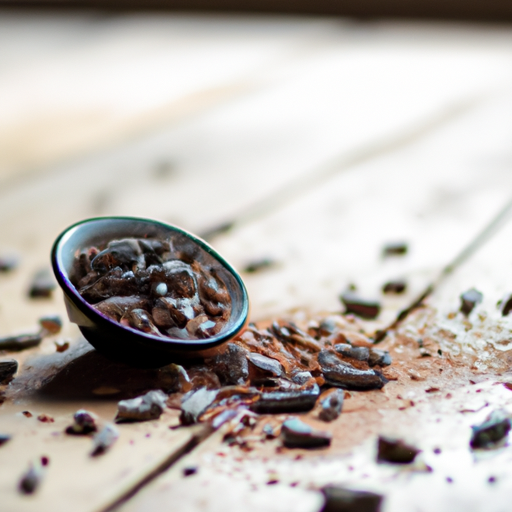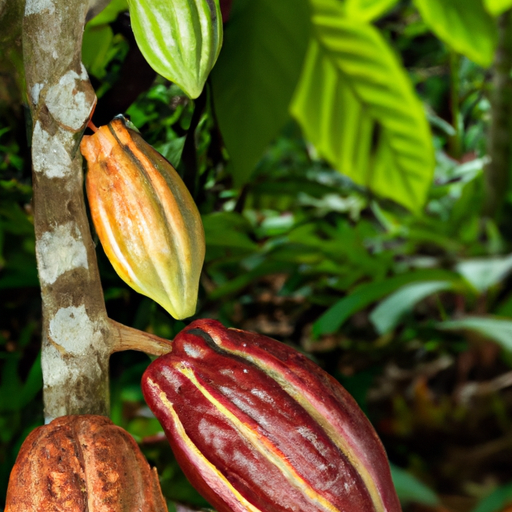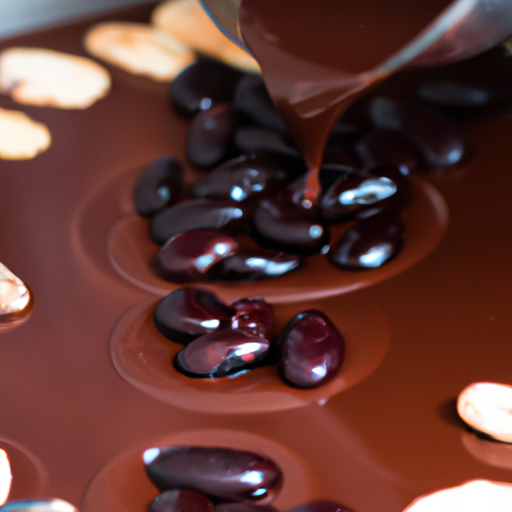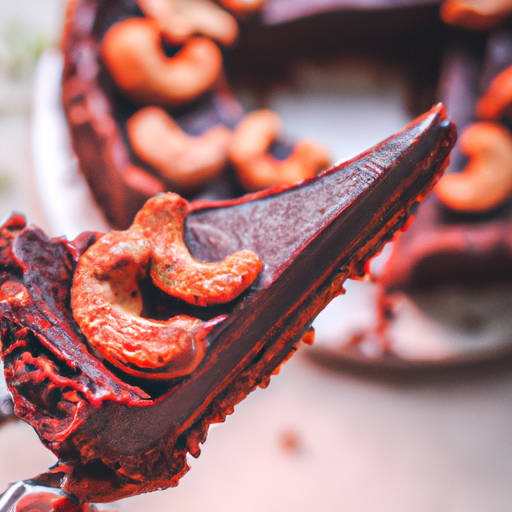While enjoying a cup of hot cocoa, I ponder the secret to its rich, velvety taste. That’s when I uncovered the magic ingredient: raw cacao nibs.
These small, crunchy pieces of pure chocolate goodness have been gaining popularity for their health benefits and delectable flavor. But how much do you really need to eat to reap the benefits?
Well, let me be your guide as we delve into the world of raw cacao nibs. In this article, I’ll provide you with evidence-based information about their nutritional composition, potential health benefits, and recommended serving sizes.
We’ll explore the ways to store and enjoy raw cacao nibs, and I’ll even address any potential side effects or precautions you should know about.
So, grab a handful of these little treats and let’s uncover the secrets of raw cacao nibs together.
Key Takeaways
- Raw cacao nibs are rich in antioxidants, fiber, magnesium, and iron.
- Incorporating them into a healthy diet can promote heart health and reduce inflammation.
- Raw cacao nibs can be used in various ways, such as adding them to smoothies, yogurt, oatmeal, or baked goods.
- It is important to consume raw cacao nibs in moderation and consult a healthcare professional if necessary, as they can have potential side effects and interactions with certain medications.
What are Raw Cacao Nibs?
Raw cacao nibs are a nutrient-dense superfood made from crushed and fermented cacao beans. They provide an abundance of antioxidants and minerals. These small, crunchy nibs have a unique and intense flavor, with notes of bitterness and a slight nuttiness. When sourced from high-quality cacao beans, raw cacao nibs offer a rich and complex taste experience.
It is important to find reputable sources for raw cacao nibs to ensure their quality and purity. They can be enjoyed on their own as a snack, added to smoothies or desserts, or used as a topping for yogurt or oatmeal. Raw cacao nibs can be a great alternative to processed chocolate products, providing a healthier option without added sugars or unhealthy additives.
Moving on to the health benefits of raw cacao nibs…
The Health Benefits of Raw Cacao Nibs
Indulging in these delectable little morsels of nature’s chocolate can be like unlocking a secret treasure chest of health benefits.
Raw cacao nibs are not just a tasty treat; they are packed with nutrients that can support both heart health and mental well-being.
These tiny nibs are rich in flavonoids, which have been shown to lower blood pressure and improve blood flow, reducing the risk of heart disease.
Additionally, the high magnesium content in raw cacao nibs can help alleviate symptoms of anxiety and depression, promoting a better mood and overall mental well-being.
To reap these benefits, it is important to incorporate raw cacao nibs into a balanced diet. However, moderation is key as they are also high in calories.
In the next section, we will explore the recommended serving size of raw cacao nibs and how to incorporate them into your daily routine.
Recommended Serving Size of Raw Cacao Nibs
When it comes to portion control of raw cacao nibs, it’s important to remember that a little goes a long way. These nutrient-dense nibs are rich in antioxidants and minerals, but they are also high in calories and fat.
To reap the health benefits without overindulging, a recommended serving size is about 1 to 2 tablespoons per day.
Incorporating raw cacao nibs into recipes can be a great way to enjoy their unique flavor and benefits. From adding them to smoothies and oatmeal to sprinkling them on top of yogurt or baked goods, there are countless delicious ways to incorporate these nutritious nibs into your diet.
Portion Control
To ensure proper portion control, you should be mindful of the amount of raw cacao nibs you consume. Here are some emotional sub-lists to consider:
-
Indulge without guilt: Enjoy a small handful of raw cacao nibs as a guilt-free treat, knowing that they are packed with antioxidants and can support heart health.
-
Savor the flavor: Sprinkle raw cacao nibs on top of your favorite smoothie bowl or yogurt for a rich, chocolatey taste that will satisfy your cravings.
-
Discover new recipes: Get creative in the kitchen and incorporate raw cacao nibs into recipes like energy balls, granola bars, or even homemade dark chocolate.
Raw cacao nibs are a nutrient-dense food, rich in fiber, iron, and magnesium. They also contain flavonoids, which have been linked to various health benefits, such as reducing inflammation and improving brain function.
When it comes to portion control, a recommended serving size is about 1-2 tablespoons per day. This amount allows you to enjoy the benefits of raw cacao nibs while still maintaining a balanced diet.
So, go ahead and experiment with incorporating raw cacao nibs into your favorite recipes to add a delicious and nutritious twist.
Incorporating into Recipes
Whip up a batch of delectable desserts by incorporating these delightful dark chocolate morsels into your favorite recipes.
Raw cacao nibs are a versatile ingredient that can add a rich, chocolatey flavor to a variety of desserts. Sprinkle them on top of your favorite homemade brownies or mix them into cookie dough for an extra burst of chocolate goodness.
For a healthier option, try incorporating raw cacao nibs into smoothie bowls. Simply blend them with frozen fruits, yogurt, and a splash of almond milk for a delicious and nutritious treat.
Remember to use raw cacao nibs in moderation, as they are high in calories and fat.
Now, let’s delve into the nutritional profile of raw cacao nibs to understand their health benefits and recommended serving sizes.
Nutritional Profile of Raw Cacao Nibs
Enjoy the rich and indulgent taste of raw cacao nibs while benefiting from their impressive nutritional profile. Here are four reasons why raw cacao nibs are a great addition to your diet:
-
Nutritional Value: Raw cacao nibs are packed with antioxidants, fiber, and essential minerals like iron and magnesium. These nutrients can support heart health, improve digestion, and boost your mood.
-
Processing Methods: Unlike processed chocolate, raw cacao nibs are minimally processed, which helps preserve their nutritional content. They are made by crushing cacao beans, removing the shells, and leaving the small pieces known as nibs.
-
Potential Health Benefits: Consuming raw cacao nibs has been linked to various health benefits, such as reducing inflammation, improving cognitive function, and enhancing exercise performance.
-
Recommended Serving Sizes: While raw cacao nibs offer numerous health benefits, it’s important to consume them in moderation. A serving size of raw cacao nibs is typically around 1-2 tablespoons.
To ensure the freshness and quality of your raw cacao nibs, learn how to store them properly without compromising their taste and texture.
How to Store Raw Cacao Nibs
Now that we know about the nutritional profile of raw cacao nibs, let’s talk about how to store them to ensure their freshness and quality.
Raw cacao nibs should be stored in a cool, dark, and dry place, such as a pantry or cupboard. It is important to keep them away from direct sunlight, heat, and moisture, as these factors can affect their taste and texture.
When stored properly, raw cacao nibs can have a shelf life of up to one year. To extend their freshness, you can also store them in an airtight container or in the refrigerator. Just make sure to bring them to room temperature before consuming to enjoy their full flavor.
Now that we know how to store them, let’s explore the various ways to enjoy raw cacao nibs in our diet.
Ways to Enjoy Raw Cacao Nibs
When it comes to enjoying raw cacao nibs, there are several delicious and nutritious options.
First, you can snack on them alone for a quick and satisfying pick-me-up.
Secondly, you can add them to smoothies or yogurt for a crunchy and flavorful twist.
Lastly, raw cacao nibs can be used in baking and cooking to enhance the taste and texture of your favorite recipes.
These versatile nibs are not only tasty but also packed with antioxidants and minerals, making them a great addition to a balanced diet.
Remember to enjoy them in moderation and consult a healthcare professional if you have any specific dietary concerns.
Snack on Them Alone
Indulge in the rich, bittersweet flavor of raw cacao nibs as you snack on them solo. These tiny treats are not only delicious but also packed with nutrients.
A quarter cup of raw cacao nibs contains around 200 calories, 15 grams of fat, and 4 grams of fiber. They are also a good source of iron, magnesium, and antioxidants.
When snacking on raw cacao nibs, it’s important to be mindful of portion size. Stick to about 1-2 tablespoons to avoid overindulging. To make your snacking experience more enjoyable, try adding a sprinkle of sea salt or a dusting of cinnamon.
These simple snacking tips can help you savor the flavor while keeping your portions in check.
Now, let’s explore how to incorporate raw cacao nibs into smoothies or yogurt.
Add to Smoothies or Yogurt
To enhance your snacking experience, imagine the velvety smoothness of adding raw cacao nibs to your favorite smoothies or yogurt. Not only does it add a rich and indulgent flavor, but it also provides numerous nutritional benefits.
Raw cacao nibs are packed with antioxidants, fiber, and essential minerals like magnesium and iron. Adding them to your smoothies can boost their nutritional profile, promoting heart health and reducing inflammation.
The crunchy texture of the nibs adds a delightful contrast to the creamy consistency of the smoothie or yogurt. Other ways to use raw cacao nibs in recipes include sprinkling them over oatmeal or incorporating them into homemade energy bars.
So don’t limit yourself to snacking on raw cacao nibs alone; explore the endless possibilities of incorporating them into your favorite recipes.
Next, we’ll dive into how you can use raw cacao nibs in baking and cooking.
Use in Baking and Cooking
Now that we’ve explored how to add raw cacao nibs to smoothies or yogurt, let’s delve into their versatility in baking and cooking.
Raw cacao nibs can be a wonderful addition to various recipes, adding a rich chocolate flavor and a satisfying crunch. When using them in baking, you can incorporate them into cookies, brownies, or muffins for a delightful twist.
In cooking, try sprinkling them over oatmeal, pancakes, or even savory dishes like chili or roasted vegetables. These nibs can withstand high temperatures, making them suitable for baking techniques like mixing, folding, or even melting.
Remember to use them in moderation, as their intense flavor can be overpowering if used excessively.
Now, let’s move on to potential side effects and precautions to keep in mind when consuming raw cacao nibs.
Potential Side Effects and Precautions
Be mindful of the potential side effects and precautions associated with consuming raw cacao nibs, so you can savor their benefits without any worries.
While raw cacao nibs are generally safe for most people, it’s important to remember that they contain caffeine and theobromine, which can cause adverse effects in some individuals. These potential risks include increased heart rate, jitteriness, and even allergic reactions.
It is recommended to start with a small amount, such as a teaspoon, and gradually increase the dosage if tolerated well. However, if you have any underlying health conditions, such as heart problems or anxiety disorders, it is best to consult with a healthcare professional before incorporating raw cacao nibs into your diet.
Additionally, be cautious about consuming raw cacao nibs if you are taking certain medications, as there may be potential interactions.
Now, let’s address some common FAQs about raw cacao nibs.
FAQs about Raw Cacao Nibs
If you have allergies, it’s important to be cautious when consuming raw cacao nibs. It’s possible to have an allergic reaction to cacao, so it’s best to consult with a healthcare professional before including them in your diet.
When it comes to children, raw cacao nibs can be safe in moderation, but it’s important to consider their individual dietary needs and potential sensitivity to caffeine.
As for weight loss, raw cacao nibs can be a part of a healthy diet, but they should be consumed in moderation and as part of a balanced approach to weight management, which includes overall calorie control and regular physical activity.
Can I eat raw cacao nibs if I have allergies?
Indulge in the rich and intense flavor of raw cacao nibs, even if you have allergies. The bittersweet taste will transport you to a world of pure delight. Raw cacao nibs are a nutritious superfood that can be enjoyed by individuals with allergies, as long as they are not allergic to cacao itself. Here are five important facts about raw cacao nibs:
- Raw cacao nibs are a calorie-dense food, making them a suitable option for those looking to gain weight.
- These nibs are high in fiber, which can support a healthy digestive system. However, individuals with digestive issues should start with small portions to assess their tolerance.
- Raw cacao nibs are rich in antioxidants, which may help reduce inflammation and protect against chronic diseases.
- The recommended serving size for raw cacao nibs is about 1-2 tablespoons per day.
- It’s important to note that raw cacao nibs may interact with certain medications, so it’s best to consult with a healthcare professional if you have any concerns.
As we delve into the safety of raw cacao nibs for children, let’s explore how this delightful superfood can benefit the younger ones.
Are raw cacao nibs safe for children?
Raw cacao nibs are generally safe for children to consume, but there are some safety precautions to keep in mind. Due to their caffeine content, it is recommended to limit the intake of raw cacao nibs in children. Excessive caffeine consumption can lead to increased heart rate and restlessness. Some children may also have allergies or sensitivities to cacao, so it’s important to monitor any adverse reactions and consult a pediatrician if necessary.
When introducing raw cacao nibs to children, it’s best to start with small amounts and observe how they respond. Moderation is key when it comes to any food. To ensure a balanced diet, it’s important to incorporate raw cacao nibs alongside a variety of other nutritious foods.
Now, let’s explore whether raw cacao nibs can help with weight loss.
Can raw cacao nibs help with weight loss?
Can raw cacao nibs help with weight loss?
Absolutely! Raw cacao nibs can play a role in controlling appetite and boosting metabolism.
These little powerhouses contain a unique combination of nutrients that can support weight loss efforts. With their high fiber content, cacao nibs can help you feel fuller for longer, reducing the likelihood of overeating.
Additionally, the natural compounds found in cacao nibs, such as flavonoids and theobromine, have been shown to have a positive impact on metabolism, aiding in the burning of calories.
However, it’s important to remember that moderation is key. While raw cacao nibs can be a healthy addition to a balanced diet, they should be consumed in appropriate serving sizes to avoid excessive calorie intake.
In the next section, we will discuss how to incorporate raw cacao nibs into a healthy lifestyle.
Conclusion: Incorporating Raw Cacao Nibs into a Healthy Lifestyle
Conclusion: Incorporating raw cacao nibs into a healthy lifestyle can provide a boost of energy and overall well-being. These delicious gems are not only tasty but also packed with nutritional benefits. Rich in antioxidants, raw cacao nibs can help reduce inflammation and protect against chronic diseases. Additionally, they are a good source of fiber, aiding digestion and promoting satiety. However, it is important to consume them in moderation due to their calorie density. A recommended serving size is about 1 ounce or roughly 2 tablespoons. This amount provides a good balance of flavor and health benefits without overindulging. So, feel free to sprinkle some raw cacao nibs on your yogurt, oatmeal, or smoothie bowl and enjoy the benefits they have to offer.
Frequently Asked Questions
Can raw cacao nibs be used as a substitute for chocolate in baking recipes?
Yes, raw cacao nibs can be used as a substitute for chocolate in baking recipes. They provide a rich chocolate flavor and are a healthier alternative due to their high antioxidant content and lower sugar content compared to cocoa powder.
Are raw cacao nibs safe for children to consume?
Raw cacao nibs can be safe for children to consume in moderation. The recommended safe dosage for children is 1-2 tablespoons per day. However, potential side effects such as caffeine sensitivity should be considered.
Can raw cacao nibs help with weight loss?
Raw cacao nibs can potentially aid weight loss by boosting metabolism and promoting appetite control. Incorporating them into a balanced diet, considering individual needs and portion control, may be beneficial.
Are raw cacao nibs suitable for those with diabetes?
Raw cacao nibs have a low glycemic index, making them suitable for those with diabetes. They can help regulate blood sugar levels and provide antioxidants and fiber. It’s important to consult a healthcare professional for personalized recommendations.
Can consuming raw cacao nibs interfere with medications or supplements?
Consuming raw cacao nibs may interact with medications or supplements, potentially leading to side effects. It is important to consult with a healthcare professional to determine if it is safe for you.
What is the Recommended Daily Amount of Raw Cacao Nibs for Maximum Benefits?
For maximum raw cacao daily benefits, nutritionists recommend consuming up to 2-3 tablespoons of raw cacao nibs per day. These nutrient-rich nibs contain antioxidants, minerals, and fiber that can support heart health, improve mood, and boost energy levels. Adding them to your diet can offer a range of health benefits.
Conclusion
In conclusion, incorporating raw cacao nibs into a healthy lifestyle is like adding a sprinkle of magic to your daily routine. These little nuggets of goodness not only offer a burst of rich flavor, but also come packed with a powerhouse of nutrients.
From heart-healthy antioxidants to mood-boosting compounds, raw cacao nibs have got it all. Just remember to enjoy them in moderation, as a little goes a long way.
So go ahead, indulge in the enchanting world of raw cacao nibs and let their goodness nourish your body and soul.










